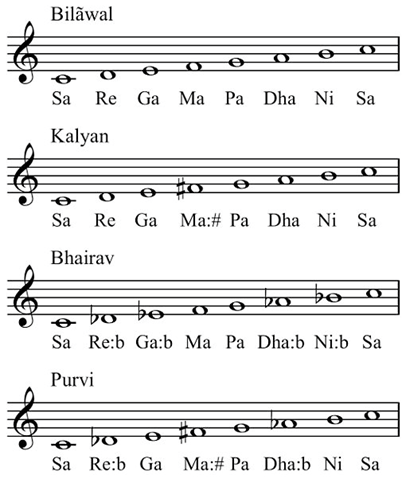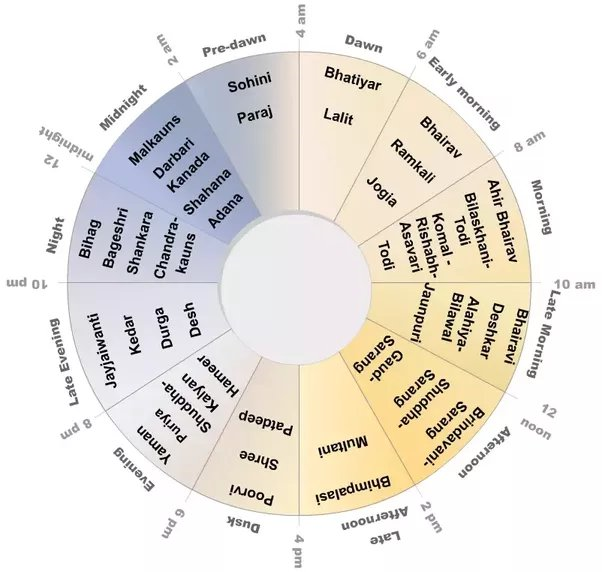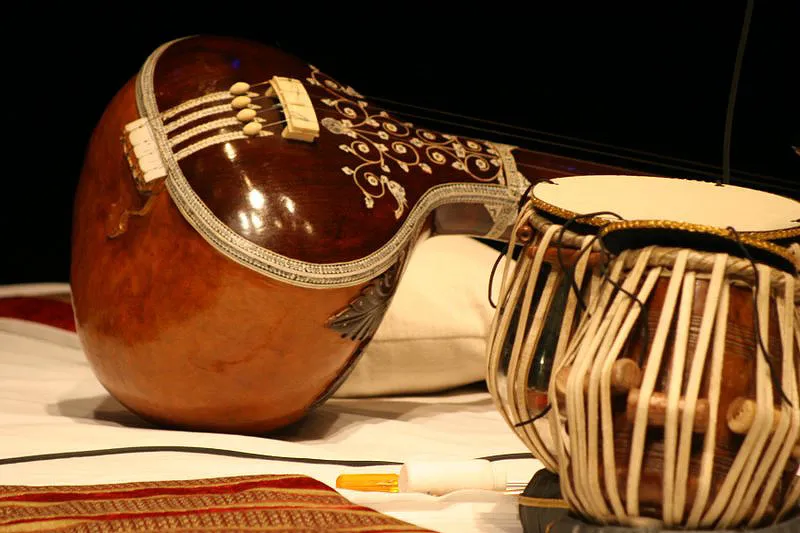RAGAS
The term Raga or Ragam has no counterpart in Western Music. The concept of Raga is almost 2000 years old. The word ‘Raga’ is derived from the Sanskrit root ‘Ranj’ (to colour, to tinge, to provide delight). The word has originated from ‘Ranjayati iti Ragah’ which means ‘that which gives pure pleasure is called Raga’. The concept of Raga is based on the idea that certain particular pattern of notes evokes a heightened state of emotion.
Raga is the name of a pitch system and there are specific formulations of pitches and tendencies. A raga is a vocabulary of notes or the musical framework for a piece of music that must contain at least 5 notes. The specific notes within the raga framework can be improvised as per the desire of the singer (notes can be elongated, truncated, emphasised) and a specific raga must be either ascending or descending. Each Raga can be defined as a melodic structure of musical notes having specific characteristic The raga can be described by its ascending and descending lines as well as its characteristic melodic features in which certain notes or certain intervals are emphasized. Artful bending of pitch around the tones of the raga is what makes the raga beautiful or valuable. Ornamentation is very important for the performance of a raga. The raga is regarded as a way to evoke certain emotions or mood in the audience. Most Indian music uses a constantly sounding pitch or set of pitches (like a drone) which gives a reference point and allows the ear to hear the inticacies of the ragas being performed. The drone is usually at the interval of the perfect 5th.
Raga, was not yet a technical term in Natya Shastra (earliest treatise on dramatic arts, including music which existed around 3rd century BC). The concept of raga evolved much later and was first explained in detail iin Matanga’s Brihaddesi around 9th century AD and later expanded in Sarngadeva’s Sangitaratnakara around the first half of 13th Century AD. The Brihaddeshi describes raga as "a combination of tones which, with beautiful illuminating graces, pleases the people in general".
The art of singing ragas had developed very well and Matanga had given the guidelines to be followed while elaborating a raga i.e. Raga Aalaapa. However, the Raga has undergone many changes through the ages but its fundamental characteristics have never been disputed. The foremost requirement of a Raga is to provide aesthetic delight to the listener’s mind. Though a musician has considerable amount of freedom while rendering a Raga, one has to stick to its basic principles and characteristics. These characteristics of the Raga have been handed down by great musicologists of India and are still being followed by the practitioners of Indian classical music. Some of the main characteristics of a raga are as follows-
- A raga cannot omit Shadja (Sa)
- A raga scale should have atleast five notes
- A raga must have a set of specific ascending and a descending notes
- A raga has a note hierarchy in which 2 particular scales receive emphasis
- In a raga, Madhyam (Ma) and Pancham(Pa) should never be omitted together
There are 2 main classical music traditions – Hindustani(North Indian) and Carnatic(South Indian and the concept of Raga is shared by both.
Both systems follow a particular form in performing a raga. A raga has a alap which is an introduction to the Raga. This introduction is accompanied by a drone and melodic instrument. The introduction can be improvised and can be with or without the accompaniment of a rhythm instrument. One the pre-composed piece begins, it has to have strict rhythm with the tala. Within the strict rhythm, various types of improvisations are allowed and they create sections.
Indian Classical music has hundreds of Ragas of which 30 are common. Each raga, state Dorothea E. Hast and others, has its "own unique melodic personality".
Examples of Ragas are as below ;

Ragas became an essential part of music in spirituality during the Bhakti movement. Bhajans and Kirtans became very popular. Bhajans are free flowing devotional compositions based on melodic ragas. Kirtans are more like an intimate conversation where 2 groups of musicians perform various ragas like a call and response structure.
The Sanskrit text Sangitaratnakara (mentioned above) belongs to the 13th century and discusses 253 ragas. It is one of the most comprehensive treatise on the structure, technique and reasoning behind ragas.
RAGAS FOR DIFFERENT TIMES OF THE DAY
In the Middle Ages, Hindustani classical music scholars (North Indian music scholars) associated particular times of day for different ragas or particular seasons. It is based on the belief that the human psyche and mind are affected by seasons and the daily biological cycle is influenced by natures rhythms. (This however is not true of the Carnatic system which is closer to the text and pays little emphasis on time or season).

There is a specific time each raga can be performed or sung and some ragas have a particular season too. The time theory of a raga is based on the swara in the raga, the vaadi(primary note of raga) and the samvaadi (special note of significance) in the raga . The vaadi and samvadi are in most cases the fourth and fifth apart. When sung properly at the right pitch, with the true vaadis and samvaadis brought forth and at the correct time, ragas create a certain mood. For example, ragas sung at dawn evoke the emotion of birds chirping in the early morning. Evening ragas are like a lullaby suitable for the night. Hence ragas depict or bring about a certain mood in the mind of the listener.
POWER OF HEALING OF RAGAS
Ancient Greeks, Arabs, and Indians were all aware of the healing powers of music, and there are legends confirming the same.Hippocratic tradition emphasised applying natural methods to healing in medicine.
In Indian philosophical practice too, sound is intrinsically related to consciousness. Nada Yoga specifically deals with this topic and focuses on developing a interaction between sound and consciousness. It is based on the premise that the entire universe and all that exists in the universe, including human beings, consists of vibrations called nada. The practice intends to synchronize chakrasthanas (location of chakras) with swarasthanas(locations of musical notes).
Swami Haridas, a classical musician of the 16th century, was one of the many who used music in treating illnesses during olden times. Practitioners of both Carnatic and Hindustani music were well aware of the power of music as a balm for the mind and body. The role of ragas in both Hindustani and Carnatic music hence besides creating mood, is aiding and curing diseases . Carnatic music training has a significant impact on auditory temporal resolution.Ragas rendered properly have the power to heal the human body. A study showed that Raga Desi Todi significantly helps reduce depression and anxiety.
In Carnatic music, there are 72 parent ragas or main ragas known as Melakarta ragas. Neural research shows that the 72 ragas control 72 nerves in the human body. Performing a raga within its specifications and with purity in pitch gives the performer complete control of the corresponding nerve. Ragas like Punnagavrali and Sahana help in calming the mind and control anger.
|
Raga |
Treatment |
|
Todi, Bhupali, Ahir Bhairav |
Provides relief from cold and headache, high blood pressure |
|
Shivaranjani |
Treats memory problems |
|
Bhairavi |
Provides relief from Sinus, cold, phlegm, toothache |
|
Chandrakauns |
Treatment of heart ailments and diabetes |
|
Darbari Kanara |
Eases tension and provides relaxation |
|
Bihag and Bahar |
For sound, sonorous sleep |
|
Darbari |
Relief from tension |
|
Malkauns, Asavari |
Cures low blood pressure |
|
Tilak-kamod, Hansdhwani, Kalavati, Durga |
Easing tension |
Ravi Shankar, the contemporary master of classical music of India writes, "Saint musicians such as Baiju Bavare, Swami Haridas or Mian Tan Sen performed miracles by performing certain Ragas [classical Indian compositions]. It is said that some could light fires or oil lamps by singing one raga, or bring rain, or melt stones, cause flowers to bloom, and attract ferocious wild animals to a peaceful quiet circle around their singing." Such is the power of Raga

